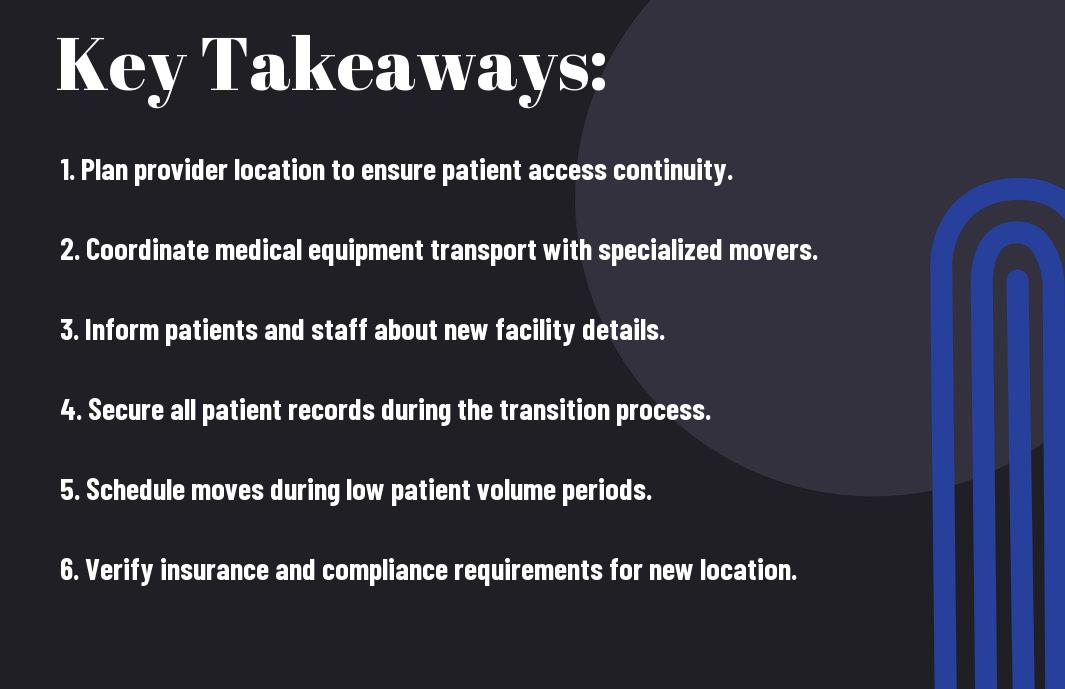Just when you think you have your healthcare needs sorted, the prospect of relocating your provider can feel overwhelming. Understanding the complexities involved in moving your healthcare provider is important for maintaining your well-being. In this post, you’ll explore the important factors to consider, from transferring medical records to finding new specialists, ensuring your transition is as smooth as possible. With the right information and strategies, you can navigate this process with ease, keeping your healthcare continuity intact.

The Complex Landscape of Healthcare Provider Transitions
Navigating the environment of healthcare provider transitions involves understanding various challenges and protocols. Hospitals and clinics frequently face restructuring, leading to shifts in personnel, affiliations, and patient services. This complexity can affect everything from patient care continuity to operational efficiency. As you move forward, being aware of these intricacies allows you to minimize disruption and improve your healthcare experience.
Key Reasons for Moving: A Provider’s Perspective
Providers often move for several key reasons, including changes in organizational structure, pursuit of better professional opportunities, and the desire to enhance patient care through new technology or partnerships. Many also seek to align their practices with evolving regulatory demands or to access greater resources that can facilitate improved service delivery. Understanding these motivations helps you appreciate the rationale behind provider transitions.
The Role of Technology in Streamlining Transitions
Technology plays a pivotal role in easing healthcare provider transitions by enhancing communication, information sharing, and logistical coordination. Tools like electronic health records (EHR) and practice management software can significantly decrease the time it takes to transfer patient records and financial data, ensuring that care remains continuous and efficient. Moreover, telehealth platforms facilitate ongoing patient engagement even during relocation.
Digital solutions provide numerous benefits in transition scenarios. For instance, implementing cloud-based EHR systems enables seamless access to patient records from any location, which is imperative when a provider changes practices. Real-time updates ensure that your health data is consistently synchronized, paving the way for uninterrupted care. Additionally, telemedicine tools keep communication lines open, allowing for follow-ups and consultations without the need for a physical presence. By embracing these technological advancements, healthcare providers can navigate transitions more effectively, maintaining a high standard of care for you throughout the process.
Navigating Regulatory Challenges in Healthcare Relocation
Relocating a healthcare facility involves overcoming numerous regulatory hurdles that can impact timelines and operational continuity. Engaging with local, state, and federal regulations ensures that your move does not compromise compliance or patient safety. Typical challenges include securing proper licenses, meeting zoning requirements, and adapting to updated healthcare regulations that may come into play during the relocation process.
Licensing and Credentialing: What You Must Know
Securing the appropriate licensing and credentialing for your new location is non-negotiable. Each state has its own requirements that dictate the necessary licenses for operation which may also vary based on the types of services you provide. Familiarizing yourself with these requirements upfront can prevent potential roadblocks down the line and facilitate a smoother transition.
Compliance with Federal and State Regulations
Abiding by federal and state regulations is not merely a formality; it’s necessary for safeguarding your practice’s reputation and patient trust. Moving a healthcare facility may trigger evaluations against regulations set forth by the Centers for Medicare & Medicaid Services (CMS) or other governing bodies, depending on your service offerings. For example, if you’re relocating a Medicare-certified institution, you may need to undergo a survey or inspection to maintain compliance with conditions for participation, ultimately ensuring your patients receive uninterrupted quality care.
Financial Implications of Moving a Healthcare Practice
Moving your healthcare practice involves various financial considerations that can significantly impact your bottom line. Factors such as moving costs, potential downtime, and the expense of setting up a new location contribute to the overall financial landscape of your relocation. In addition to direct costs, you need to assess how the move might affect your revenue streams, patient retention rates, and operational efficiency during the transition. Planning adequately for these financial implications will ensure that your practice can weather the shift without severe repercussions.
Budgeting for Relocation: Hidden Costs to Consider
Crafting a relocation budget requires meticulous attention to often-overlooked expenses. Besides the obvious costs such as movers or rental deposits, you should factor in expenses related to utilities setup, renovations needed to comply with healthcare regulations, and potential increases in insurance premiums. Additionally, consider the costs incurred from staff downtime or lost patient appointments, as these expenses can accumulate quickly and impact your cash flow during the transition.
Funding Options: Grants, Loans, and Financial Support
Securing financial support for your move can ease the burden on your practice, enabling you to focus on a smooth transition. Various funding options are available, including government grants tailored for healthcare providers, small business loans, and other financial assistance programs that may be applicable. Researching local and federal resources, as well as health-specific financial institutions, can uncover valuable support to help cover the costs associated with your practice’s relocation.
You may find grants specifically aimed at enhancing access to healthcare in underserved areas, presented by organizations such as the U.S. Department of Health and Human Services. Additionally, consider low-interest loans from the Small Business Administration, which can provide funds for relocation and renovations. Resource links and contact information for these programs can often be found through professional healthcare associations, which can be a key step in obtaining the financial support you need to facilitate a successful move. Be proactive in reaching out to financial advisors who specialize in healthcare to help you navigate these options effectively.
Patient Retention Strategies During and After Transitions
During and after a relocation, implementing effective patient retention strategies is important to maintain loyalty and trust. Engaging with patients proactively by addressing their concerns, emphasizing continuity of care, and assuring them of service quality helps mitigate uncertainty. Offering reassurances about their healthcare experience and reinforcing your commitment to their well-being can foster a sense of security, ultimately leading to higher retention rates during a challenging transition period.
Communicating Change: Best Practices for Patient Engagement
Clear and transparent communication is vital for engaging patients during your relocation. Utilize multiple channels, including emails, newsletters, and social media, to inform patients about the transition timeline, new location details, and expected changes. Personalizing messages can enhance connections, demonstrating that you value their relationship. Additionally, scheduling town hall meetings or Q&A sessions can create an interactive platform for patients to voice concerns, promoting dialogue and trust in your practice.
Creating a Seamless Patient Experience
To ensure a seamless patient experience during relocation, prioritize logistical planning and patient support systems. Simplifying appointment scheduling through online platforms can ease transitions, allowing patients to adjust to new logistics effortlessly. Additionally, ensuring that your staff is well-prepared to address questions and provide personal support during the relocation helps maintain continuity and comfort for patients. Streamlining processes, from record transfers to follow-up appointments, will create an environment that reduces patient anxiety and fosters goodwill.
Designing a seamless patient experience during your move requires meticulous attention to detail. Begin by evaluating the new facility to ensure it meets familiar standards, both in terms of layout and service delivery. Arrange for consistent and thorough patient data management, ensuring no records get lost in the shuffle. Consider training staff on the specifics of the new location and any changes in procedures or services. Proactively reaching out to patients can include sending personalized emails or making phone calls to check in on their experiences and concerns. Quickly addressing any issues can make a difference in patient perception, reinforcing their confidence in your care amid transition challenges.
The Future of Healthcare Provider Mobility: Trends and Predictions
As healthcare provider mobility evolves, technological advancements and patient demands shape future developments. Increased emphasis on flexibility in practice locations, the integration of telehealth services, and enhanced patient engagement strategies will impact how providers relocate and manage their practices. Expect more healthcare organizations to adopt hybrid models, blending traditional care with virtual options, allowing for seamless transitions, improved collaboration, and increased accessibility for patients across geographical boundaries.
Insights from Industry Experts: What Lies Ahead
Professionals within the healthcare industry predict a significant shift towards patient-centered mobility solutions. Experts emphasize that healthcare providers will increasingly use data-driven decisions to determine optimal practice locations and offer personalized care options. This transformation will rely heavily on technology to facilitate patient-provider connections and maintain continuity of care during transitions.
The Evolving Role of Telehealth in Provider Transitions
Telehealth is reshaping how healthcare providers manage transitions, enabling them to maintain ongoing relationships with patients regardless of geographic barriers. Providers can now conduct follow-ups, consultations, and wellness checks virtually, ensuring continuity of care even when moving. This approach not only enhances patient satisfaction but also helps maintain revenue streams as you adapt your practice to new locations. Ultimately, telehealth’s role will continue to expand, offering innovative solutions to streamline transitions in the ever-evolving landscape of healthcare delivery.
To wrap up
Considering all points, navigating healthcare provider moving solutions requires a strategic approach to ensure a smooth transition. You must assess your current needs, communicate effectively with stakeholders, and plan meticulously to minimize downtime and disruptions. By staying informed about regulatory requirements and exploring various options, you can make confident decisions that best serve your practice and patients. Ultimately, being proactive and organized will facilitate a successful relocation while maintaining the quality of care your patients expect.

